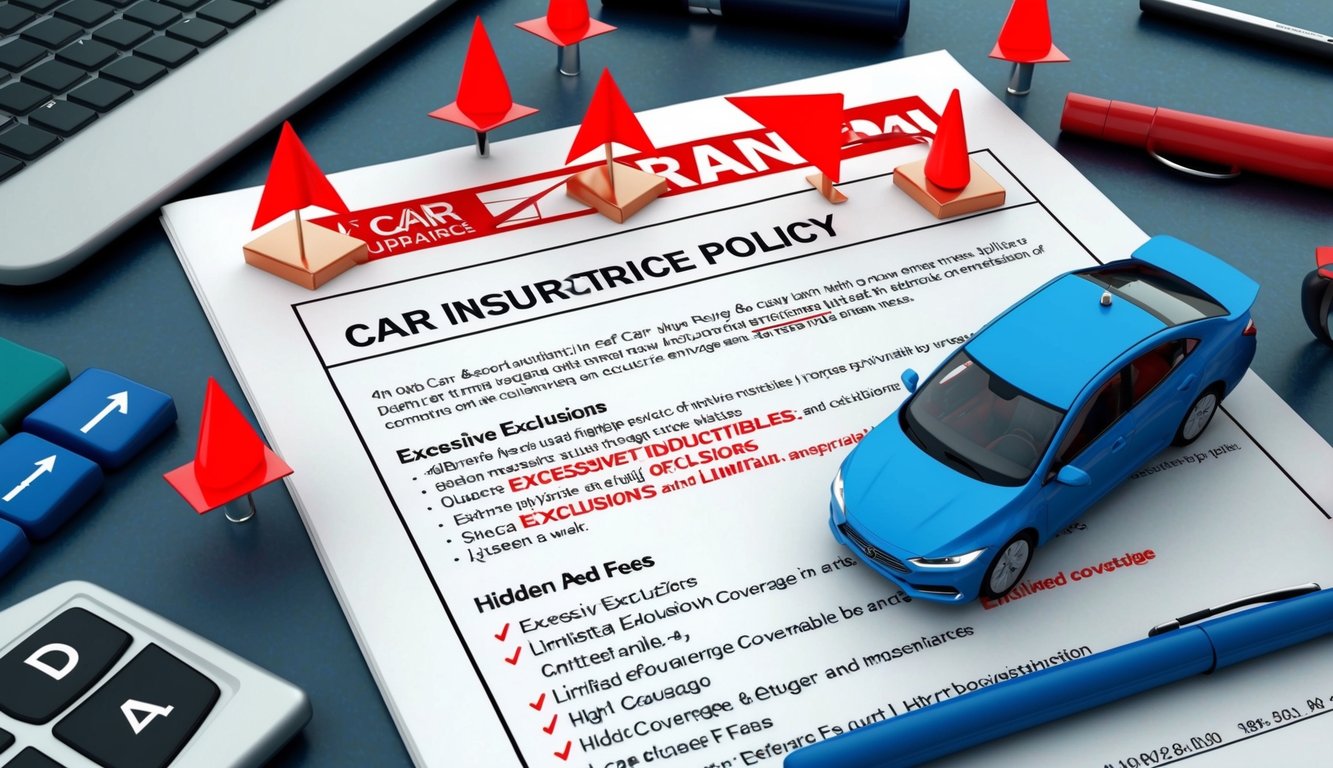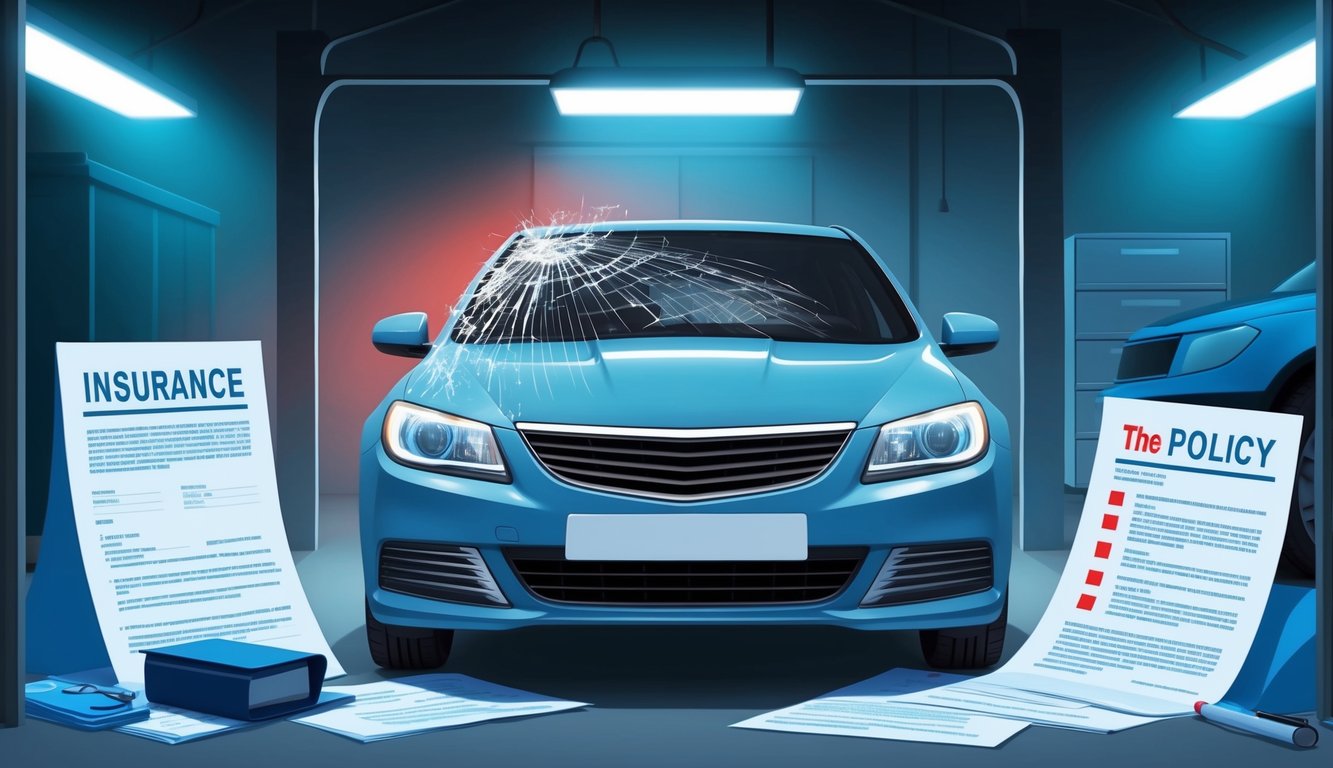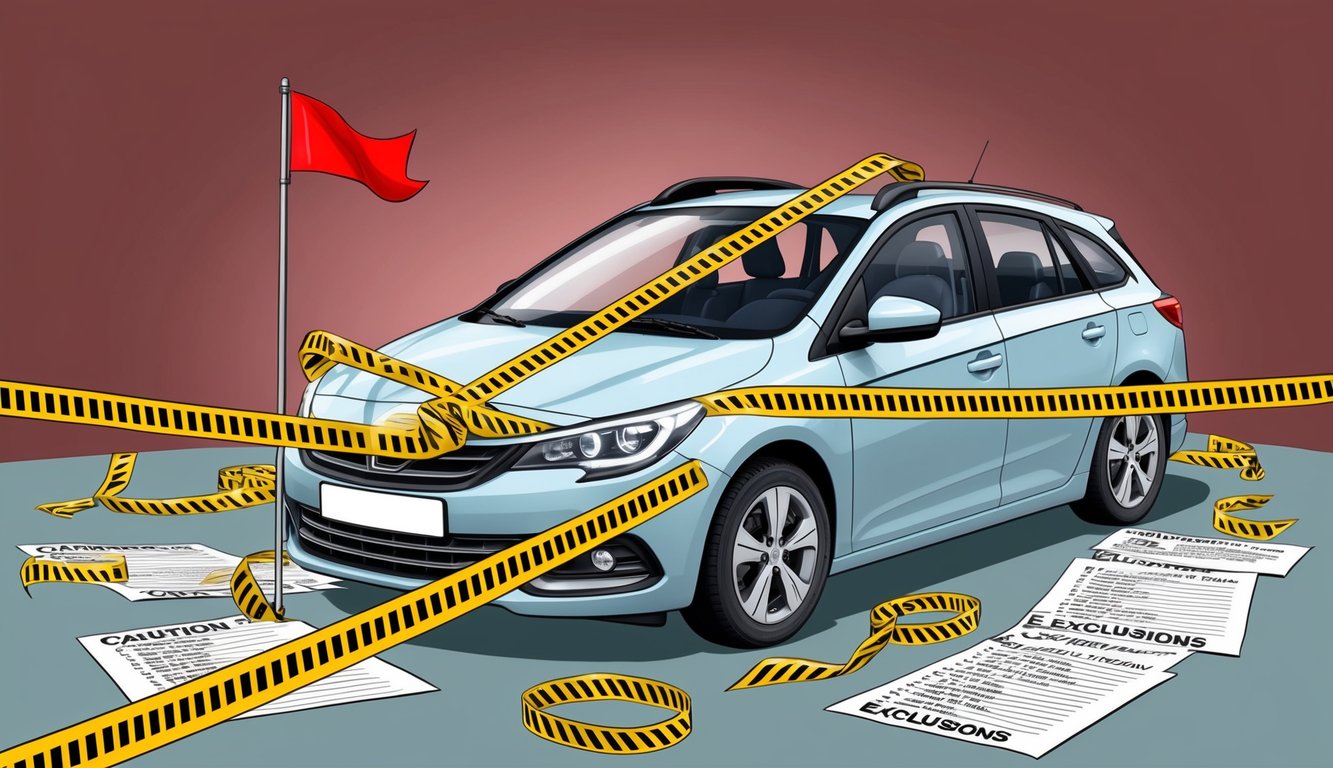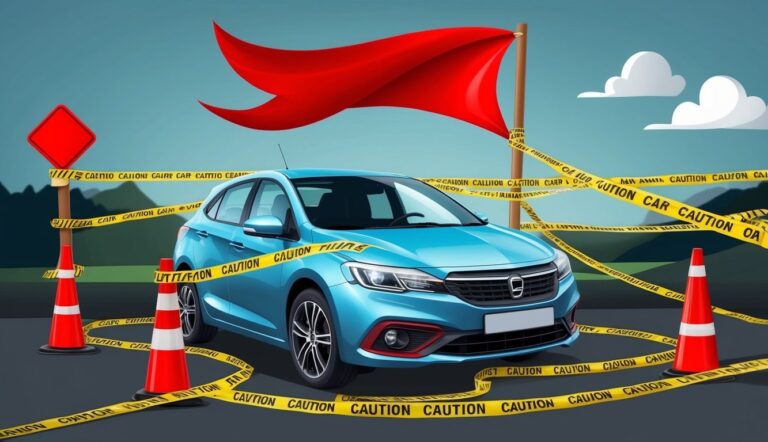When you shop for car insurance, you should carefully review policy details before signing on the dotted line.
Many consumers find themselves overwhelmed by the fine print and industry jargon, potentially missing important clauses or limitations. Familiarizing yourself with common red flags in car insurance policies can help you make more informed decisions and avoid potential pitfalls down the road.
Car insurance is designed to protect you financially in case of accidents or unforeseen events involving your vehicle.
However, not all policies are created equal, and some may contain provisions that limit coverage or increase your out-of-pocket expenses.
Being aware of these warning signs can help you choose a policy that truly meets your needs and provides the level of protection you expect.
1) High Deductibles

High deductibles can be a red flag in car insurance policies.
A deductible is the amount you pay out of pocket before your insurance coverage kicks in.
While high deductibles can lower your premiums, they may leave you financially vulnerable in case of an accident.
Many drivers set their deductibles at $500 or $1,000.
If you see a policy with a significantly higher deductible, it’s worth scrutinizing carefully.
Consider your financial situation when evaluating deductibles.
Can you comfortably afford to pay the deductible if you need to file a claim? If not, a high deductible policy might not be the best choice for you.
Be aware that raising your deductible from $200 to $500 could decrease your premiums by 15% to 30%.
While this sounds appealing, weigh the potential savings against the risk of higher out-of-pocket costs.
Remember that deductibles apply each time you file a claim.
If you have multiple incidents in a year, you’ll need to pay the deductible for each one.
When shopping for car insurance, compare policies with different deductible levels.
This will help you find the right balance between affordable premiums and manageable out-of-pocket costs.
2) Low Coverage Limits

Low coverage limits in your car insurance policy can leave you financially vulnerable in the event of an accident.
Many states require minimum liability coverage, but these limits are often inadequate for real-world situations.
For example, Virginia’s minimum liability coverage is 30/50/20, meaning $30,000 per person for bodily injury, $50,000 maximum for bodily injury per accident, and $20,000 for property damage.
These amounts may not fully cover expenses in a serious accident.
Higher coverage limits offer better protection.
Consider opting for at least 100/300/100 coverage, which provides $100,000 per person for bodily injury, $300,000 per accident for bodily injury, and $100,000 for property damage.
Be cautious of policies that only meet state minimums.
While they may seem cost-effective, they could leave you responsible for significant out-of-pocket expenses if you’re involved in a major accident.
Remember, insurance liability limits represent the maximum amount your insurer will pay per claim.
Anything beyond these limits becomes your responsibility.
When reviewing your policy, pay close attention to the coverage limits.
Ensure they align with your assets and potential risks.
Adequate coverage can protect you from financial hardship in the long run.
3) Exclusions for Common Events

Car insurance policies often contain exclusions for events that may seem common.
You should be aware of these to avoid unpleasant surprises when filing a claim.
One frequent exclusion is for wear and tear or mechanical failures.
Your policy likely won’t cover repairs due to normal aging or lack of maintenance.
Regular upkeep is crucial to prevent such issues.
Acts of nature like floods, earthquakes, or hurricanes may also be excluded from standard policies.
You might need additional coverage for these events, depending on where you live.
Some policies exclude coverage when using your car for commercial purposes, such as ride-sharing or food delivery.
If you use your vehicle for such activities, inform your insurer to ensure proper coverage.
Police seizure of your vehicle due to non-payment or legal issues is typically not covered.
Your insurer won’t reimburse you in these situations.
Be cautious of policies with unreasonable exclusions that limit coverage for common and expected events.
These can significantly reduce your protection and may indicate a problematic policy.
Always read your policy carefully and ask your insurer about any exclusions you don’t understand.
Being informed helps you make better decisions about your coverage needs.
4) Lack of Rental Car Coverage

When reviewing car insurance policies, pay attention to rental car coverage.
Many policies don’t automatically include this protection, leaving you vulnerable if you need to rent a vehicle.
Without rental coverage, you might face unexpected costs if your car is in the shop after an accident.
You’d have to pay out of pocket for a rental, which can quickly add up.
Rental car insurance can be crucial when traveling.
If your policy lacks this coverage, you might feel pressured to purchase expensive insurance from the rental company.
Check if your policy offers a loss of use provision.
This covers the rental company’s lost income while their vehicle is being repaired if you damage it.
Consider the daily limits on rental coverage.
Some policies may only cover a certain amount per day, which might not be enough for the type of vehicle you need.
Look for policies that offer extended rental periods.
If your car needs lengthy repairs, you’ll want coverage that lasts long enough to keep you mobile.
Be aware of any restrictions on the type of rental vehicle covered.
Your policy might not cover luxury cars or larger vehicles like trucks or vans.
If your policy lacks rental coverage, ask your insurer about adding it.
It’s often an affordable add-on that can save you money and stress in the long run.
5) Unreasonable Premium Increases
Car insurance premiums often fluctuate, but sudden, significant increases should raise concerns.
While some factors like inflation or increased claims can lead to higher rates, unreasonable hikes may indicate a red flag in your policy.
Pay attention to your annual renewal notices.
If you notice a substantial jump in your premium without any apparent reason, it’s time to investigate.
Compare your new rate to industry averages and your previous year’s costs.
Recent data shows that many drivers are experiencing higher premiums due to inflation and increased accident rates.
However, your personal rate increase should still be within reasonable limits.
If your driving record hasn’t changed and you haven’t filed any recent claims, question large increases.
Contact your insurance provider to understand the reasons behind the price hike.
Insurance companies may raise rates due to factors beyond your control, such as increased repair costs or a rise in accidents in your area.
However, they should be able to explain these increases clearly.
Be wary if your insurer can’t provide a satisfactory explanation for the premium increase.
This could be a sign of bad faith practices or an attempt to push you towards canceling your policy.
Consider shopping around if you encounter unreasonable increases.
Compare quotes from multiple providers to ensure you’re getting a fair deal.
Remember, a competitive market should keep premiums in check.
6) No Accident Forgiveness
Accident forgiveness is a valuable feature that can protect you from rate increases after your first at-fault accident.
If your policy lacks this coverage, it’s a potential red flag worth considering.
Many insurers offer accident forgiveness as an optional add-on to your policy.
This feature typically prevents your premium from increasing after your first accident, even if you’re at fault.
Without accident forgiveness, a single mishap could lead to significantly higher rates.
This can be especially concerning if you have a clean driving record and want to maintain affordable premiums.
Some companies, like Erie Insurance, automatically include accident forgiveness for loyal customers with good driving records.
If your insurer doesn’t offer this benefit, it might be worth shopping around.
Keep in mind that accident forgiveness usually comes at a cost.
It may increase your premium by up to 10%, depending on the insurer.
You’ll need to weigh this additional expense against the potential savings in case of an accident.
If you’re a safe driver, the absence of accident forgiveness might not be a deal-breaker.
However, it’s worth considering how this could impact your rates in the event of an unexpected accident.
Remember, policies and offerings vary between insurers.
Always read the fine print and ask your agent about accident forgiveness options when comparing policies.
7) Limited Roadside Assistance

Roadside assistance can be a lifesaver when you’re stranded on the side of the road.
However, some car insurance policies offer limited coverage that may leave you in a bind.
Pay close attention to the number of incidents covered per year.
Some plans restrict you to as few as four rescues annually.
This limitation could prove problematic if you frequently encounter car troubles.
Examine the types of services included in your plan.
Basic coverage might only offer towing and battery jump-starts.
More comprehensive plans include lock-out services, fuel delivery, and tire changes.
Check the maximum towing distance allowed.
Some policies limit towing to as little as 5-10 miles.
If you live in a rural area or frequently travel long distances, this restriction could result in hefty out-of-pocket expenses.
Be aware of reimbursement caps.
Certain plans only cover up to $150 per incident.
This amount may not suffice for more complex breakdowns or long-distance tows.
Look for exclusions in the policy.
Some plans don’t cover motorcycles, RVs, or trailers.
Others might not assist if you’re stuck in snow or mud.
Consider the response time guarantee.
Quality roadside assistance should arrive within a reasonable timeframe.
Be cautious of plans that don’t offer any guarantees on arrival times.
Evaluate the availability of service.
Ensure the plan provides 24/7 coverage and operates in all areas you typically travel.
Some budget plans may have limited service areas or hours.
8) Excessive Cancellation Fees

When reviewing car insurance policies, be wary of excessive cancellation fees.
These fees can catch you off guard if you decide to switch providers or cancel your policy before its term ends.
Some insurance companies charge significant fees for early cancellation.
These may be flat fees around $50 or a percentage of your remaining premiums, often up to 10%.
It’s important to understand your insurer’s cancellation policy before signing up.
Ask about any potential fees and compare them to other providers’ policies.
Be aware that cancellation fees can vary by state and company.
Some states have laws limiting these fees, while others allow insurers more flexibility in setting them.
Short rate cancellation fees are a specific type to watch out for.
These can be particularly costly, as they’re calculated based on the time remaining on your policy.
To avoid surprises, carefully read the fine print in your policy documents.
Look for sections detailing cancellation terms and associated costs.
If you find the cancellation fees excessive, consider negotiating with your insurer or shopping around for policies with more reasonable terms.
9) Lack of Online Account Management
In today’s digital age, online account management is a crucial feature for car insurance policies.
If an insurer doesn’t offer this option, it’s a red flag you shouldn’t ignore.
Online account management allows you to easily access your policy details, make payments, and file claims from your computer or smartphone.
Without this feature, you may face unnecessary hassles and delays when dealing with your insurance.
A lack of online tools can also indicate that the insurance company is behind the times technologically.
This might translate to slower processing of claims and less efficient customer service overall.
Modern insurance companies typically provide robust online platforms.
These allow you to view your coverage, update personal information, and even request policy changes without having to call or visit an office.
If you’re considering a policy that doesn’t offer online account management, ask yourself why.
Is the company trying to make it harder for you to access your information or make changes to your policy?
Remember, convenience matters.
A user-friendly online interface can save you time and frustration, especially when you need to access your insurance information quickly.
Before committing to a policy, inquire about the insurer’s digital capabilities.
If they fall short of your expectations, it might be wise to look for alternatives that offer more comprehensive online services.
10) Restrictions on Car Modifications
Car modifications can significantly impact your insurance coverage.
Many policies have strict limitations on vehicle alterations, potentially leaving you underinsured if you’ve made changes to your car.
Insurance companies often view modifications as increased risk factors. Lowering your car’s suspension or making engine modifications may raise red flags due to safety concerns.
It’s crucial to review your policy’s stance on modifications.
Some insurers offer customizable solutions to address individual risk factors, but these may come at a higher cost.
Certain modifications might require special coverage.
For example, Progressive offers up to $5,000 for custom components under comprehensive and collision coverage.
Not all modifications need to be reported. Tinting windows, changing paint, or installing extra lights typically don’t interest insurers.
However, it’s best to err on the side of caution and inform them of any significant changes.
Be aware that some modifications may even be illegal in your state. Common prohibited modifications include excessively loud exhausts, certain frame and suspension alterations, and extreme window tinting.
Always consult with your insurance provider before modifying your vehicle.
This ensures you understand how changes might affect your coverage and helps you avoid potential legal issues.
Understanding Policy Terms
Insurance policies contain specific language and terminology that can greatly impact your coverage.
Familiarizing yourself with these terms is crucial for making informed decisions about your car insurance.
Common Terminology
Vague and open-ended terms like “reasonable,” “customary,” “necessary,” and “material” can be interpreted differently depending on context.
Be cautious of these ambiguous words in your policy.
Pay attention to phrases such as “actual cash value” and “replacement cost.” These define how your vehicle will be valued in case of a total loss.
Exclusions are specific situations or circumstances not covered by your policy.
Review this section carefully to understand potential gaps in your coverage.
Deductibles represent the amount you’ll pay out-of-pocket before your insurance kicks in.
Higher deductibles often mean lower premiums, but consider your financial situation when choosing.
Contract Lengths
Car insurance policies typically have set terms, often six or twelve months. Policy renewal is the process of extending your coverage for another term.
During renewal, your insurer may reevaluate your premium based on factors like claims history and driving record.
Be prepared for potential changes in your rates.
Some insurers offer month-to-month policies.
While these provide flexibility, they often come at a higher cost compared to longer-term contracts.
Consider your future plans when choosing a contract length.
If you anticipate changes in your driving habits or vehicle ownership, a shorter term might be beneficial.
Evaluating Coverage Limits
Understanding your car insurance policy’s coverage limits is crucial for protecting yourself financially.
Proper evaluation ensures you’re adequately covered in case of an accident or damage to your vehicle.
Liability Limits
Liability coverage is typically expressed as three numbers, such as 25/50/25.
These represent the maximum payouts for bodily injury per person, bodily injury per accident, and property damage, respectively, in thousands of dollars.
Many experts recommend higher limits than state minimums.
For example, 100/300/100 coverage provides $100,000 for bodily injury per person, $300,000 per accident, and $100,000 for property damage.
Consider your assets when choosing limits.
Higher coverage protects you from potential lawsuits if you cause a severe accident.
Comprehensive and Collision Coverage
Comprehensive and collision coverages protect your vehicle from damage.
These policies usually have deductibles, which you pay before insurance kicks in.
Lower deductibles mean higher premiums, while higher deductibles reduce your monthly costs but increase out-of-pocket expenses if you file a claim.
For newer or more valuable cars, lower deductibles might be worth the extra cost.
Older vehicles may not need comprehensive or collision coverage if their value is low.
Review your car’s worth and your financial situation to determine appropriate coverage levels and deductibles.
Adjust these as your vehicle ages or your circumstances change.
Hidden Fees and Charges
Car insurance policies often contain unexpected costs that can significantly impact your total expenses.
Be vigilant and carefully review your policy documents to identify and understand these potential financial pitfalls.
Cancellation Fees
When terminating your car insurance policy early, you may face cancellation fees.
These charges can range from $25 to $50 or even a percentage of your remaining premium.
Some insurers impose higher fees if you cancel within the first year.
To avoid surprises, ask about cancellation fees before signing up.
Consider:
- Short-term policies if you’re unsure about long-term commitments
- Timing your cancellation to minimize fees
- Switching providers at renewal time to sidestep cancellation charges
Always read the fine print regarding policy termination.
Some companies may offer a grace period allowing fee-free cancellations within the first few weeks.
Surcharges and Penalties
Insurance companies may add surcharges or penalties to your premium for various reasons.
These can include:
- Late payment fees: Typically $10-$15 per occurrence
- Insufficient funds charges: If your automatic payment fails
- Reinstatement fees: If your policy lapses due to non-payment
- Paper billing fees: Some insurers charge for mailed statements
To minimize these costs:
- Set up automatic payments
- Opt for electronic billing
- Pay your full premium upfront if possible
Be aware of potential convenience fees for credit card payments.
These fees can be up to 4% of your premium.
Consider using bank transfers or checks to avoid these charges.






